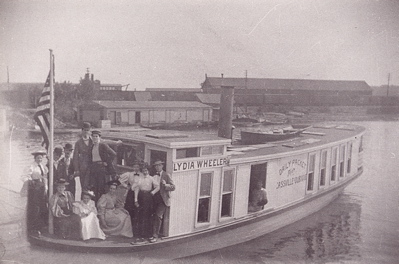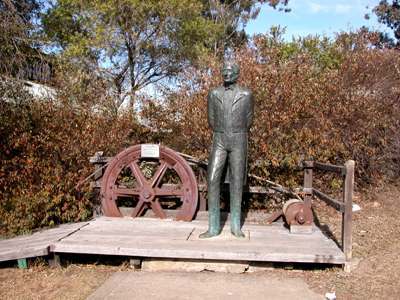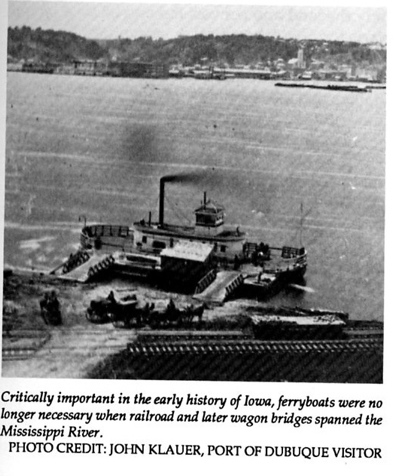Encyclopedia Dubuque
"Encyclopedia Dubuque is the online authority for all things Dubuque, written by the people who know the city best.”
Marshall Cohen—researcher and producer, CNN
Affiliated with the Local History Network of the State Historical Society of Iowa, and the Iowa Museum Association.
FERRYBOATS
FERRYBOATS. Early method of transportation across the MISSISSIPPI RIVER. Regular ferry service across the river began in the spring of 1837. A large boat was placed in service with paddle wheels on both sides. A team of horses on board the boat turned the wheels. Cargo included teams and wagons, passengers, and livestock. The life of this ferry was short. Struck by a steamer the same spring, the ferry sank. The succeeding ferryboat was powered with oars. The toll for one adult was twenty-five cents. It was estimated that the ferry right, then owned by General George Wallace JONES, was worth twenty-five thousand dollars annually.
An act of the Iowa Territorial Legislature in December 1838, authorized Timothy Fanning to operate a ferry at Dubuque for twenty-five years. As part of his authorization, Fanning had to maintain ample landing facilities and was required to land at any part of the Dubuque riverfront. Within two years, Fanning was in command of a steam ferryboat and several smaller craft. Fanning was later a party in the case of FANNING V. GREGOIRE that reached the United States Supreme Court.
General Jones was granted the right to operate a ferry from Dubuque in January 1840. His twenty-year charter did not conflict with the authorization given to Fanning as his boats could use neither steam nor horses for power.
In the spring of 1848 Dubuque demanded a free ferry across the river or a cessation of high ferry rates. As high as $1 had been charged in emergencies for ferry usage.
The steam ferry "A. F. Gregoire" began transporting morning and evening mail between Dunleith and Dubuque in 1855.
In May 1876 the ferry "Key City" made a trial run to Zollicoffer's Lake. It entered into service between Dubuque and Dunleith on May 11, 1876. (1)
The development of RAILROADS to the eastern shore of the Mississippi River posed a new challenge to ferryboat operators by the 1850s. The Illinois Central leased a ferry out of Dubuque to transport cargo from a train in Illinois to another train waiting in Iowa. This system proved satisfactory until the volume of goods became too great. The Illinois Central then pioneered the use of larger ferryboats with tracks laid on the deck to transport entire railroad cars. Loaded cars were pushed into a floating dock or "cradle" from which they were loaded on to the ferryboat. This became standard procedure until the construction of the first railroad bridge in 1871 that ended the business of the Illinois Central Ferry Company.
Difficulty in entering the Dubuque ICE HARBOR in the mid-1800s led many river pilots to threaten they would quit unless the sandbar was cleaned from the river. So important was the Dubuque harbor that Congress appropriated $15,000 in 1877 for this removal effort. Dredging left the water's depth at a minimum of six feet.
Ice annually brought a complete standstill to ferryboat operation. Some boat operators, like a Captain Worden in April 1859, attempted to crush their way across the river. In such an attempt, the "Aeolian" was so badly damaged that it sank in thirty feet of water with the loss of four passengers.
Construction of the HIGH BRIDGE meant an end to most freight transportation after 1877. Only small passenger ferries were operating by 1890. One of the last successful ferryboat operators was John Keckevoet who began operations in 1891. His "Nina Dousman" was fifty feet long, nine feet wide, and carried fifty passengers. A round trip to Dunleith took five minutes. In his most profitable year, Keckevoet earned $90,000.
---
Source:
1. "Caught on the Fly," Dubuque Herald, May 10, 1876, p. 4. Online: https://news.google.com/newspapers?nid=uh8FjILnQOkC&dat=18760510&printsec=frontpage&hl=en
Oldt, Franklin T. History of Dubuque County, Iowa. Chicago: Western Historical Company 1880 http://www.ebooksread.com/authors-eng/franklin-t-oldt/history-of-dubuque-county-iowa-being-a-general-survey-of-dubuque-county-histor-tdl/page-9-history-of-dubuque-county-iowa-being-a-general-survey-of-dubuque-county-histor-tdl.shtml




